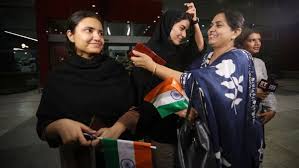Flight carrying 110 Indian students, evacuated to Armenia from Iran, lands in Delhi

New Delhi, June 19, 2025 – Relief swept through Indira Gandhi International Airport as 110 Indian students returned home after being evacuated from Iran. Their arrival marked the first successful phase of Operation Sindhu, India’s response to the escalating conflict between Iran and Israel.
A Flight to Safety
The special flight took off from Yerevan, Armenia, where Indian officials had moved the students after helping them cross the Iran-Armenia border. Most of them were pursuing medical degrees at Urmia University in northern Iran. As the conflict intensified, they found themselves stuck without a safe exit.
India’s diplomatic teams coordinated their evacuation swiftly. On June 18, the group boarded a rescue flight that landed in Delhi in the early hours of June 19.
Students Share Their Ordeal
Sameer Sheikh, a final-year student, described the fear they lived with for days. “We heard explosions every day. Electricity would vanish without warning. Even our hostels didn’t feel safe,” he said.
Communication blackouts added to their distress. “When the strikes began, we couldn’t even get a signal to call home,” shared Nidhi Sharma, another student from Himachal Pradesh. “It was terrifying not knowing if we could talk to our families again.”
Students recalled long nights without sleep, food shortages, and the constant sound of sirens and distant blasts. Their stories painted a vivid picture of life in a war zone.
India’s Swift Response
Minister of State for External Affairs Kirti Vardhan Singh welcomed the students at the airport. He assured families that evacuation efforts were still underway.
“We have about 4,000 Indians in Iran, including around 2,000 students. More rescue flights are scheduled via Armenia and Turkmenistan. Our teams are working round the clock,” he said.
India has set up help desks and emergency control rooms in Delhi and Tehran. Embassy staff remain in close contact with stranded citizens, guiding them toward the nearest evacuation points.
Drawing from Past Success
Operation Sindhu adds to India’s growing record of successful international rescue missions. Past operations like Operation Ganga (Ukraine, 2022) and Operation Kaveri (Sudan, 2023) have followed similar frameworks of rapid diplomatic coordination and military logistics.
Security expert Colonel (Retd.) Ajay Mishra said India’s network of diplomatic allies proved crucial. “We’ve built strong ties with Armenia and Turkmenistan. Their cooperation has made this possible,” he noted.
Reunions Filled with Emotion
At the airport, emotional reunions unfolded. Families hugged their children tightly. Tears flowed freely. For many, this was a moment they feared might never come.
“I couldn’t sleep for days,” said Alka Yadav, whose son was among the evacuees. “Now he’s back, but his friends are still there. I pray they all return safely.”
Parents expressed gratitude toward government officials and embassy staff. Social media flooded with thank-you messages from relieved families.
Concerns Remain
Although these students are now safe, questions remain about their academic futures. Many fear delays in their studies or complications with transferring credits.
Some universities in Iran have suffered damage. It’s unclear when classes will resume. Indian authorities are exploring ways to help students continue their education, possibly through partnerships with universities in other countries.
Psychological support is also being planned for returning students. The trauma of witnessing conflict, even from a distance, can have lasting effects.
What Lies Ahead
Evacuations will continue over the coming days. Government officials are urging Indian nationals in Iran to register with the embassy and follow all advisories.
Multiple rescue routes are being used. Armenia and Turkmenistan serve as the main transit points. Flights will operate based on logistics, border permissions, and safety conditions.
“We are in constant contact with our people in Iran. We won’t stop until every Indian is back home,” Minister Singh emphasized.
Conclusion
Operation Sindhu reflects India’s rising capacity for international crisis management. The return of these 110 students is a milestone, but the mission continues. Thousands more remain in uncertain and dangerous conditions.
As the government works to bring them home, one thing is clear: India’s commitment to protecting its citizens remains strong, no matter how far from home they are.






